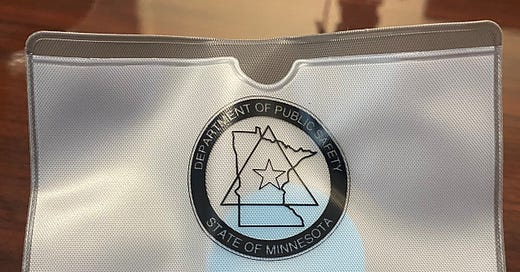This morning CNN ran a segment on price inflation and what it means for American households. The piece was centered on the Stotlers of Texas, following the family of 11 as they did their weekly grocery shopping in the Dallas-Forth Worth suburbs. Anchor Brianna Keilar promoted the segment by highlighting this jaw-dropping quote from the mom: “A gallon of milk was $1.99. Now it's $2.79. When you buy 12 gallons a week times four weeks, that's a lot of money.”
Many commentators had a hard time believing that a family could possibly go through that much milk in a week (although I have to note, as a father of three boys, that in per-capita terms it’s not that different from my own family’s milk consumption).
But where CNN really fumbled this one is on the specific inflation claims made by the family — claims that were presented at face value, with no effort by the reporter or anchor to provide context or hard data. Those claims include:
That the price of milk in the Dallas-Fort Worth area has risen by roughly 40 percent;
The mom’s statement that “in June, a dollar was worth a dollar. And now that dollar is worth 70 cents.”
That a recent grocery expenditure of $310 would have cost $150 or $200 back in March, when prices were lower.
Let’s start with the milk prices. The U.S. Department of Agriculture actually maintains detailed, monthly data on the price of milk in various U.S. cities (big tip of the hat to data scientist Dan Nguyen on this). That data shows that in Dallas, the average price of milk rose from $2.86 in January of this year to $3.22 in October — about 13 percent. That’s a real increase, and nothing to sneeze about if you’re on a budget. But it’s a very long way from the 40 percent figure that CNN chose to highlight.
I suppose it’s possible the Stotlers had been buying insanely cheap milk somewhere that recently got a lot more expensive, but if so that’s the sort of claim that could use some fact-checking — show us the (grocery) receipts! Especially if you’re going to make it the centerpiece of the segment.
Then there’s the mom’s impression of inflation overall. Her formulation (“now that dollar is worth 70 cents”) suggests something like 40 percent overall inflation since June. But again, there’s hard data on this: official federal figures show that prices overall in Dallas are up by roughly 1.5 percent from May to September. Certain high-salience items, like milk and maybe gasoline, are up by more than that. But nothing’s close to the 40 percent rate implied by the folks in the CNN segment.
Finally, there’s the claim that $310 in groceries today would have cost 30 to 50 percent less earlier this year. Yet again, we can compare this to official federal data on how the price of food overall is changing. While frequent city-level figures are harder to come by, the national picture is that food prices are up roughly 5 percent since this period last year. Again: a real increase, and undoubtedly a cause of hardship among some families! But nowhere near the levels implied in the CNN segment.
Now, I don’t expect a news outlet to fact-check regular people the same way they do politicians — they’re just speaking off the cuff, and shouldn’t be expected to know the precise levels of economic indicators in their regions. And on some level it’s useful to know how families are experiencing big macro trends like inflation — to the Stotler family it *feels* like milk prices are up by 40 to 50 percent this year, which is helpful in understanding how voters might be reacting to the current economic climate.
But I do expect news outlets to present individual experiences like this in the context of what the actual data show. To say something like “official federal figures show that the price of milk in Dallas is up nearly 15 percent since January. But to some families, like the Stotlers, it feels like prices are up even more than that.”
But CNN makes no effort to do anything like this. Instead, the reporter lends credence to the dodgy numbers by saying, in his own voice, that “the Stotlers are feeling the inflation squeeze to the tune of an extra $100 a week, they say. That’s just for groceries.” The segment also explicitly positions the Stotlers’ experience as emblematic of what the typical American family is facing: “I went to Kennedale Texas,” the reporter says at the opening of the piece, “to go shopping with a family, to talk about what this actually means to live in America right now.”
Setting the inflation numbers aside, it’s worth noting the Stotlers are a huge family — 9 kids in the house at the moment! They’re a big outlier in terms of household size. That leads to another major omission in the CNN report — the Stotlers are almost certainly receiving monthly child tax credits to the tune of $250 or $300 per kid, adding up to close to $2,500 per month. That covers their reported excess grocery expenditure six times over! But the question of tax credits, and of the steps the government is already taking to help families experiencing financial difficulties, are not mentioned.
In the end, you have a major news network painting an exaggerated and ultimately misleading picture of the extent and severity of inflation in the U.S. The reporter and anchor absolutely know this, and they know that the Stotlers’ experience isn’t typical — on Twitter the reporter says as much! The episode is a vivid illustration of how the industry norm of “just repeat what people tell you without adding context” doesn’t serve anyone well — CNN viewers have been misled about inflation, the reporter and anchor are getting a lot of backlash and vitriol online, and the family at the center of the story is undoubtedly going to be subject to some of it too.
It sucks, for everyone involved! There’s got to be a smarter way to report on this stuff.












